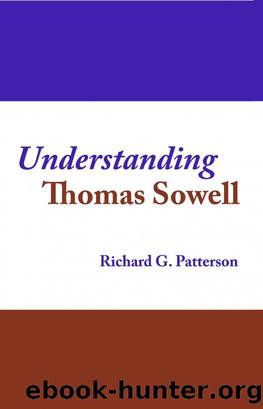Understanding Thomas Sowell by Richard Patterson

Author:Richard Patterson
Language: eng
Format: epub
Tags: libertarian, free market, hayek, liberal, sowell, political rhetoric, systemic rationality
Publisher: Richard Patterson
Rationality and Rhetoric: Strategies of the Anointed
The Vision of the Anointed has two major themes: 1) policies based on the prevailing vision since the 1960s have backfired and 2) those failed policies have not been abandoned or corrected because of the rhetorical strategies with which the intellectual / liberal elite suppress evidence of failure. If Sowell had been content just to debate the success or failure of specific policies, I would never have attempted to analyze his philosophical or sociological assumptions, although I might have occasionally read what he had to say about policies that particularly concerned me. I shall make no attempt here to evaluate the statistical or anecdotal evidence Sowell provides to show how various policies have failed. Others are far more qualified to do that. [6.1] I am more interested in the context of that debate and whether Sowell sheds light on the obstacles to substantive debate that seem at times to have become insurmountable.
For 20 or 30 years Sowell has been sounding the alarm about the direction in which our society seems to be headed. His efforts to find the underlying causes for the changes he saw led him to his theory of âvisionsâ which produce ideological differences. The âunconstrained visionâ (aka âthe vision of the anointedâ) became the prevailing vision and has been guiding policy for 50 years.
After the vision of the anointed was given increasing scope in the education and public policy of the United States and other Western societies during the decades beginning with the 1960s, the social degeneration became palpable, documented beyond issue, and immense across a wide spectrum of social phenomena â declining educational standards, rising crime rates, broken homes, soaring rates of teenage pregnancy, growing drug usage, and unprecedented levels of suicide among adolescents. This social devastation was not due to poverty, for the material standard of living was rising substantially during this time. It was not due to repression, for an unprecedented variety of new ârightsâ emerged from the courts and legislatures to liberate people from the constraints of the law while they were being liberated from social constraints by the spread of ânonjudgmentalâ attitudes. Neither was the social degeneration due to the disruptions of war or natural catastrophes, for it was an unusually long period of peace, and science conquered many diseases that had plagued the human race for centuries, as well as providing better ways of protecting people from earthquakes and other destructive acts of nature. It was instead an era of self-inflicted wounds. [6.2]
The dominance of the unconstrained vision is something that needs to be explained if it is responsible for this social degeneration. As we have seen Sowellâs concept of a vision is such that it should be capable of being validated. A vision can be transformed into theories, which in turn can yield hypotheses to be tested. Empirical data will then reveal whether the theory is valid or not. This has not happened and, to the extent that social policies based on the prevailing vision are failing, the evidence against the vision is simply being ignored.
Download
This site does not store any files on its server. We only index and link to content provided by other sites. Please contact the content providers to delete copyright contents if any and email us, we'll remove relevant links or contents immediately.
The remains of the day by Kazuo Ishiguro(8341)
Tools of Titans by Timothy Ferriss(7743)
Giovanni's Room by James Baldwin(6752)
The Black Swan by Nassim Nicholas Taleb(6725)
Inner Engineering: A Yogi's Guide to Joy by Sadhguru(6407)
The Way of Zen by Alan W. Watts(6258)
Asking the Right Questions: A Guide to Critical Thinking by M. Neil Browne & Stuart M. Keeley(5322)
The Power of Now: A Guide to Spiritual Enlightenment by Eckhart Tolle(5294)
The Six Wives Of Henry VIII (WOMEN IN HISTORY) by Fraser Antonia(5199)
Astrophysics for People in a Hurry by Neil DeGrasse Tyson(4976)
12 Rules for Life by Jordan B. Peterson(4141)
Housekeeping by Marilynne Robinson(4019)
The Ethical Slut by Janet W. Hardy(4010)
Skin in the Game by Nassim Nicholas Taleb(3945)
Double Down (Diary of a Wimpy Kid Book 11) by Jeff Kinney(3878)
Ikigai by Héctor García & Francesc Miralles(3832)
The Art of Happiness by The Dalai Lama(3821)
Skin in the Game: Hidden Asymmetries in Daily Life by Nassim Nicholas Taleb(3699)
Walking by Henry David Thoreau(3660)
